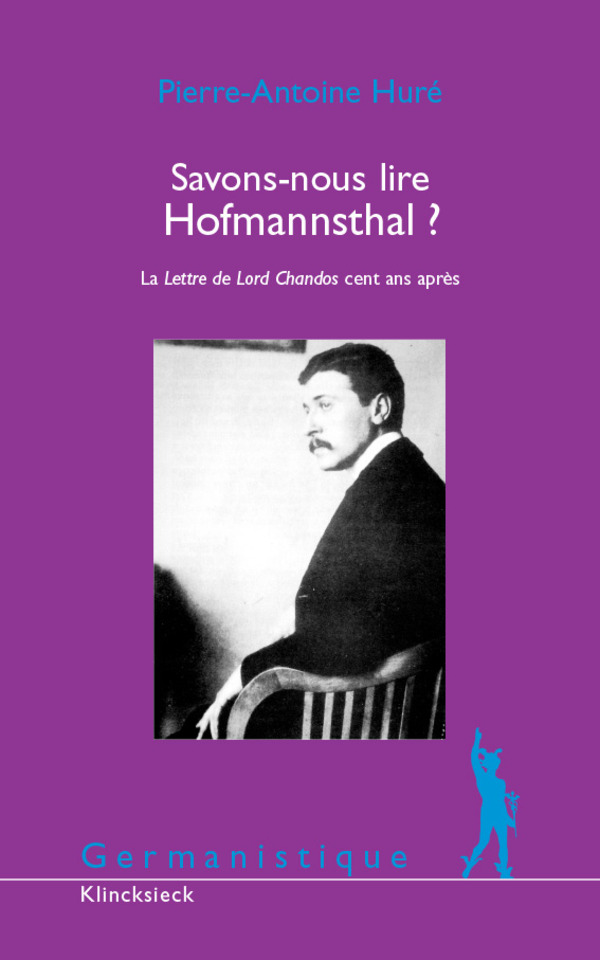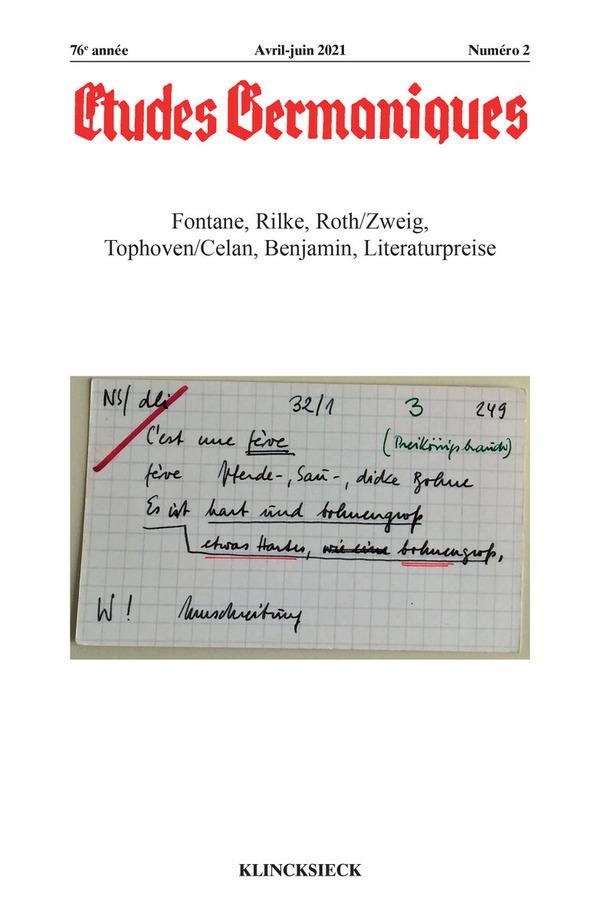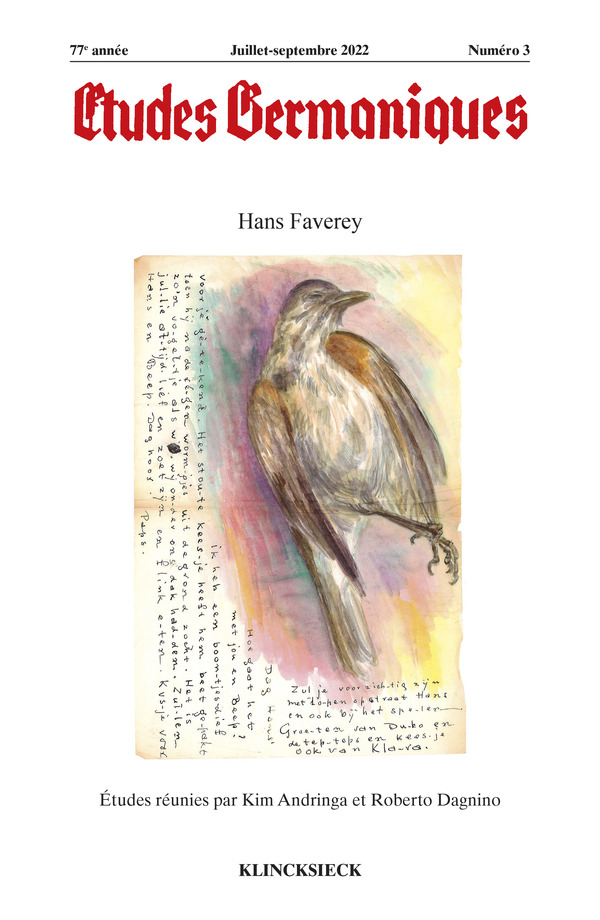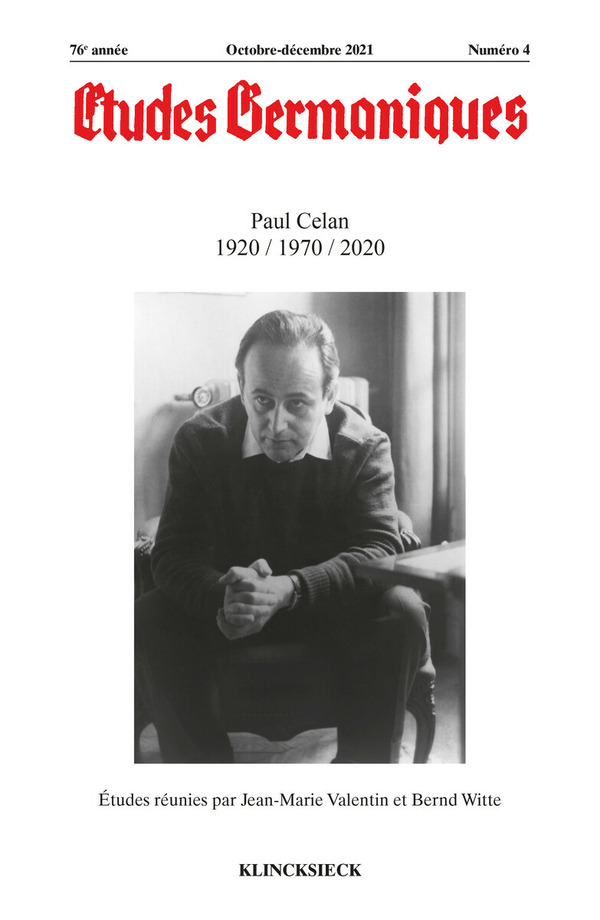Études germaniques - N°2/2014
La poésie d'Ernst Jandl
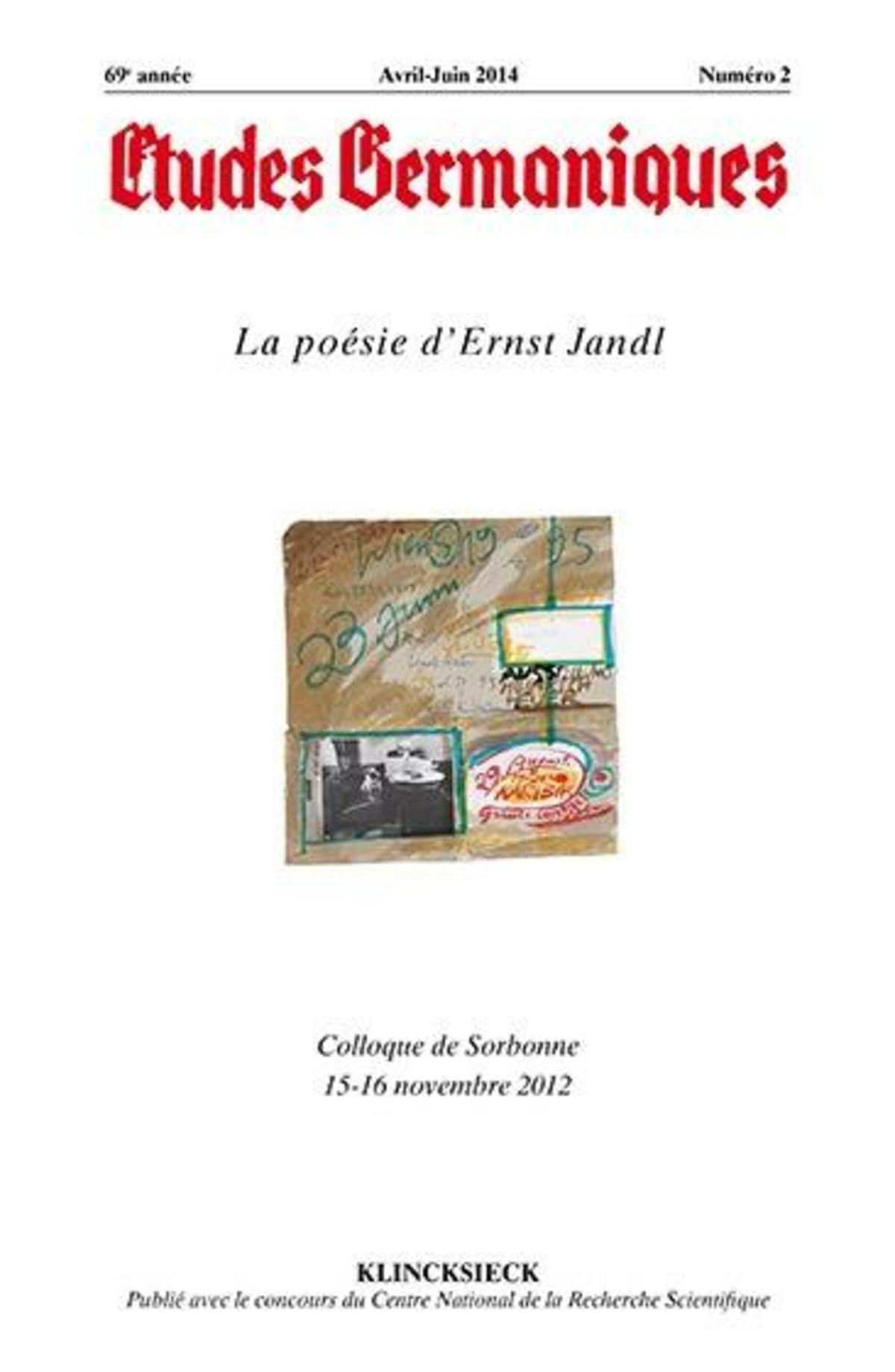
- 176 pages
- Livre broché
- 15 x 23 cm
- Études germaniques
- Parution : 25/07/2014
- CLIL : 3439
- EAN13 : 9782252039236
- Code distributeur : 47938
Présentation
RESUMES
Laurent CASSAGNAU, Voir le corps de la langue, écouter la langue du corps. Ernst Jandl et la critique du logocentrisme.
This article discusses the work of Ernst Jandl from the viewpoint of those twentieth century thinkers who challenge the idea of a transcendent logos, which pervades the Western tradition in the guise of God, Being, or Truth. According to Derrida, logos never broke its original link with phonè, the voice through which a divine pneuma find expression. Phonocentrism is therefore the corollary of logocentrism : it devalues writing as a merely secondary trace of voice, and it presupposes a system of values which subordinate the written text to the mind, and the materiality of the body to the immateriality of the noumenon. Against the signifier's duty of transparency towards the signified, Jandl, just like his Dadaist predecessors, overcomes the opposition between the written word and its meaning through a poetic "materialism". However, he neither gives priority to oral performance by declaring it the sublime purpose of writing, nor does he exclusively value the mute visuality of typography. On the contrary, Jandl's poetry is the scene where the written equals the spoken word, it is a post-Dadaist overcoming of differentiation or – to use Derrida's words – a play of differance that endlessly defers the signified in a chain of signifiers.
Jandls Werk wird hier vor dem Hintergrund der zeitgenössischen Infragestellung eines transzendenten Lo-gos untersucht, so wie die abendländische Tradition ihn als Gott, Sein, Wahrheit, usw. postulierte. Nach J. Derrida hat der Logos seine ursprüngliche Bindung an die phonè als Ausdruck des göttlichen pneuma nie aufgelöst. Der Logozentrismus geht also mit einem Phonozentrismus einher : er wertet die Stimme auf bei gleichzeitiger Entwertung der als bloße sekundäre Spur aufgefassten Schrift, er setzt ein Wertesystem voraus, das den Buchstaben dem Geist, und die Materialität des Körpers der Immaterialität des Numinosen unterordnet. Auf das Transparenzgebot des Signifikanten gegenüber dem Signifikat antwortet Jandl, ähnlich wie seine dadaistischen Vorgänger, mit einem ‚Materialismus', der die gängige Opposition zwischen Buchstaben und Geist überlistet. Von einem prinzipiellen Vorrang der vokalen Performance als Endbes-timmung jeglicher Grafie kann bei Jandl sowenig die Rede sein wie von einer ausschließlichen Aufwertung des Visuell-Schriftlichen. Jandls Gedicht ist der Ort einer Gleichsetzung und -bewertung der Schriftlichkeit und der Mündlichkeit, einer postdadaistischen Indifferenzierung, oder auch, um Derridas Terminologie wiederaufzunehmen, einer différance, d.h. des ständigen Aufschubs des immer wieder von Signifikant zu Signifikant verlegten Sinns.
Michael HAMMERSCHMID, « von dialogen » Formen, Tendenzen und Spannungen Jandl'scher Dialogizität
Ernst Jandl's poems are well known of beeing espacially communicative. They provoke dialogs with their readers particularily by playing with words and different elements of language. But it is more complex than that. The following article tries to work out this complexity and variety of the dialogue in his poetry. By sho-wing how Ernst Jandl invents new forms of dialogs sometimes even by rejecting them, his poetical ap-proach shall be described as an indirect way of communication, full of social, semantical, psychological etc. tensions, he works with.
La poésie d'Ernst Jandl se caractérise par toutes sortes d'ambivalences et de tensions. Elle engage le dia-logue avec le lecteur en jouant tout particulièrement sur les mots et les différents éléments verbaux. Mais elle est en fait plus complexe. Le présent article se propose d'examiner la complexité et variété du dialogue dans la poésie de Jandl, en montrant comment le poète invente de nouvelles formes de dialogues, en les rejetant parfois. On peut considérer cette approche poétique comme un moyen détourné de communiquer, plein de tensions sociales, sémantiques, psychologiques, etc., sur lesquelles Jandl travaille.
Elisabeth KARGL – Aurélie LE NÉE, Variations sur les formes. Les sonnets dans le recueil Idyllen d'Ernst Jandl
Ernst Jandl's poetry is based on the tradition while going beyond it. The analysis of this correlation is the heart of this article which gives an interpretation of the sonnets in the Idyllen, a volume which was published in 1989. Since the “Leerform des Sonetts” in the sixties, the radicalness of the experiment steps back, but the problematisation of the traditional form remains. In Idyllen, several sonnets indicate it : the first sonnets with their poetological dimension, sonnets like hohe kunst whose subjects are body and material, sonnets which criticize religion, or others which break away with classical literary tradition. Jandl's work on the sonnets in the Idyllen shows us that his poetry sets in some “in-betweenness” which is typical for his creation.
Ernst Jandls Dichtung stützt sich auf die Tradition und überwindet sie zugleich. Die Untersuchung dieser Wechselbeziehung steht im Zentrum des vorliegenden Artikels, der die Sonette im 1989 veröffentlichten Gedichtband Idyllen analysiert. Seit der « Leerform des Sonetts » in den 1960er Jahren tritt zwar die Ra-dikalität des Experimentellen in den Hintergrund, die Problematisierung der traditionellen Form wird dennoch fortgesetzt. In den Idyllen lässt sich das an mehreren Sonetten ablesen : die ersten Sonette mit ihrer poetologischen Dimension, Sonette wie hohe kunst, die Körperlichkeit und Materialität thematisieren, So-nette, welche die Religion kritisieren, oder andere, die sich von der klassischen literarischen Tradition ent-fernen. Jandls Bearbeitung der Sonette in den Idyllen zeigt, dass seine Dichtung in einem « Dazwischen » liegt, das typisch für sein Werk ist.
Françoise LARTILLOT, Autobiographie et poésie chez Ernst Jandl. D'un procès l'autre
The relationship that Ernst Jandl maintains with the question of the autobiographical resembles that found in the works of other poets, who are primarily interested in playing with « figures of the biographical » in their poems, a game with transgressive aspects which illuminate the historical and critical positioning of the work. In the works of Jandl, who often creates variations on the autobiographical form, one can observe that this « writing exhibiting autobiographical features » is based on a tension between an unwelcome form of sentimentality which is excessive and another form which is restrained but appropriate. This tension finds echoes in the work to the extent that the poem gives objective form to the subjective, in other words to the extent that it circles around the objectal element as if it were a medium prohibiting mediation ; this on the one hand constitutes the comic aspect of the work and on the other hand is meant to praise the human dimension and save it. It is this poetic movement which is analysed here.
Ernst Jandl geht nicht anders mit dem Autobiographischen um als einige Dichter, bei denen es vor allem darum geht, mit Figuren des Biographischen in ihren Gedichten zu spielen, ein Spiel dessen grenzüber-schreitender Aspekt gleichzeitig den historischen und kritischen Stellungswert des Werks offenbart. Bei Jandl, der seinerseits oft autobiographische Formen variiert hat, kann man beobachten, wie dieser Literatur mit autobiographischen Zügen in ihrer Vielfalt, ein Spannungsverhältnis zwischen überschwenglicher, unangebrachter Sentimentalität und zurückgehaltener aber gerechter Sentimentalität zugrunde liegt. Dieses Spannungsverhältnis geht in das Werk ein, indem das Gedicht das Subjektive objektiviert, d.h. um das Objektale kreist als ein nicht vermittelndes Medium, das einerseits den komischen Charakter des Werks ausmacht und andererseits das Menschliche preisen und retten will, eine poetische Bewegung die in diesem Aufsatz analysiert wird.
Helmut NEUNDLINGER, « lieber ein saxophon ». Ernst Jandl und der Jazz
This article deals with the affective relation of the Austrian poet Ernst Jandl to Jazz Music, especially mo-dernist styles like bebop and free jazz. It tries to show how the music influenced his own poetic experiments. The article evolves a methodical analyse of the jazz-patternlike structure of some of Jandl's poems and contains a few remarks concerning Jandl's co-operation with Austrian Jazz musicians.
Cet article, qui traite du rapport qu'entretenait Ernst Jandl au jazz, et plus particulièrement au bebop et au free jazz, tente de montrer dans quelle mesure la musique a influencé les expérimentations poétiques de Jandl. Il analyse la parenté de structure de certains poèmes de Jandl avec l'écriture musicale du jazz, et évoque également les coopérations entre le poète et des musiciens de jazz autrichiens.
Astrid NISCHKAUER, Ernst Jandl – Ian Hamilton Finlay. Freundschaft, Zusammenarbeit und wechselseitige Beeinflussung
The article discusses the friendship, collaboration and mutual influence between Ernst Jandl and Ian Ha-milton Finlay. Both artists were close friends and exchanged letters over a long period. Their collaboration will be illustrated by means of two examples – on the one hand Ernst Jandl's poems written for « POTH », Ian Hamilton Finlay's literary journal (Poor Old Tired Horse) and on the other hand Ian Hamilton Finlay's installation in the Schweizergarten in Vienna.
L'article traite de l'amitié, de la collaboration et de l'influence mutuelle entre Ernst Jandl et Ian Hamilton Finlay. Les deux artistes étaient très amis et ont correspondu pendant de longues années. Leur collabora-tion sera illustrée par deux exemples, d'une part les poèmes d'Ernst Jandl écrits pour « POTH », le jour-nal littéraire d'Ian Hamilton Finlay (Poor Old Tired Horse – pauvre vieux cheval fatigué) et d'autre part l'installation d'Ian Hamilton Finlay dans le Schweizergarten à Vienne.
Bettina THIERS, Ernst Jandl und die Stuttgarter Gruppe
This article focuses on the beginnings of Ernst Jandl in the field of experimental literature through the study of his correspondence with the German concrete poet and specialist in German studies, Reinhard Döhl. For the first time in Germany, Reinhard Döhl helped Jandl to publish parts of his manuscript Laut und Luise and introduced him to the « Stuttgarter Gruppe », a group of concrete poets gathered around Max Bense and Helmut Heissenbüttel and based in Stuttgart. This relation to the Stuttgarter Gruppe brought him the publicity he needed, as he could finally publish the whole manuscript Laut und Luise with the help of Heissenbüttel and Döhl. These links with Stuttgart also seems to have had an influence on Jandl's experimental writing, as it appears in the letters he exchanged with Döhl.
Cet article revient sur les débuts d'Ernst Jandl sur la scène de la littérature expérimentale à travers l'étude de sa correspondance avec le poète concret et germaniste de Stuttgart Reinhard Döhl. Ce dernier permit à Jandl de publier une partie du manuscrit Laut und Luise pour la première fois en Allemagne et l'introduisit dans le cercle du « Groupe de Stuttgart » autour de Max Bense et Helmut Heissenbüttel. Outre la no-toriété que lui apporta la fréquentation du groupe et la publication de Laut und Luise grâce à Döhl et Heis-senbüttel, la relation avec le groupe de Stuttgart et avec R. Döhl en particulier semble avoir eu une influence sur l'écriture expérimentale de Jandl, comme il ressort de ses lettres à Döhl.
Dirk WEISSMANN, Stop making sense ? Ernst Jandl et la traduction homophonique
This paper deals with Ernst Jandl's contribution to the history of homophonic translation. The origin and the evolution of this unconventional form of poetic translation has yet not been addressed by extensive scholarship. Jandl, however, with his poem oberflächenübersetzung, can be described as one of the pioneers of this genre. As will be shown, his homophonic translation is closely related to his experimental poetry of the late 1950s and early 1960s, and can be read, among others, as a critical and ironic statement against poetry translation that focuses exclusively on meaning. In addition to a detailed analysis of Jandl's poetics of homophonic translation my paper will address the question of the connections between Jandl's specific translation method and its precursors and successors in Europe and the U.S.
Der vorliegende Artikel beschäftigt sich mit Ernst Jandls Beitrag zur Geschichte der homophonen Überset-zung. Untersuchungen zur Entstehung und Entwicklungslinien dieser unorthodoxen Form der poetischen Übersetzung sind bis heute ein Desideratum der Forschung. Es kann jedoch festgestellt werden, dass Jandl mit seinem Text oberflächenübersetzung einer der Pioniere dieser Übersetzungsgattung war. Jandls homophone Übersetzung ist eng mit seiner experimentellen Dichtung der späten 1950er und frühen 1960er Jahre verknüpft und lässt sich unter anderem als kritisch-ironisches Statement gegen ein allzu sinnfixiertes Lyrikübersetzen lesen. Neben einer genauen Analyse von Jandls Übersetzungsverfahren soll der Frage der Verbindungen von Jandls homophoner Übersetzungsmethode zu Vorläufern und Nachfolgern in Europa und den USA nachgegangen werden.
Jean-Marie VALENTIN, Vienne et l'opéra impérial baroque. Un système, une symbolique
From the crowning of Leopold I (in 1658) to the death of Charles VI (in 1740), Vienna, whose role as the capital of the Holy Roman Empire was not to be contested until the ascendancy of Prussia, earned a repu-tation as one of the most important musical centres in Europe. Its position was particularly decisive in baroque Italian opera of Venetian origin. Performances were held at court. These brilliant performances, held in the Emperor's presence, were the fruit of a system based upon three solid pillars : the poeta Cesareo, the composer and the stage designer. These shows, drawing from antique, Christianised mytho-logems, were of exceptional quality. The main motif, in constant use, was the self-glorification of the Habs-burg dynasty, which was deliberately staged, identifying the dynasty with its historic mission.
Von der Krönung Leopolds 1. (1658) bis zum Tode Karls VI. (1740) behauptete sich Wien, dessen Bedeu-tung als Hauptstadt des alten Reiches bis zu Preußens Aufstieg nicht ernsthaft umstritten werden kann, als eines der wichtigsten Zentren der Musikpflege in Europa. Seine Stellung war vor allem im Bereich der ba-rocken, in italienischer Sprache gegebenen Oper venezianischer Provenienz ausschlaggebend. Ort der Aufführungen war der Hof. Die glanzvollen Vorstellungen, die in Gegenwart des Kaisers veranstaltet wur-den, entstammten einer genau durchdachten kollektiven Zusammenarbeit, die auf drei stabilen Säulen be-ruhte : Dem poeta cesareo, dem Komponisten und dem sog. « Bühnenarchitekten ». Antike christiani-sierte Mythologeme bemühend war diese Produktion von exzeptionellem Niveau. Ständig wiederkehrendes Hauptthema war die Verherrlichung der sich selbstbewusst in Szene setzenden, sich mit ihrer historischen Mission identifizierenden Habsburgerdynastie.
Biographies Contributeurs
Jean-Marie Valentin
Jean-Marie Valentin est professeur à la Sorbonne, titulaire de la chaire d'histoire culturelle du monde germanique de l'Institut universitaire de France. Membre du Haut Conseil culturel franco-allemand et de la Deutsche Akademie f ür Sprache und Dichtung, il dirige aux éditions Klincksieck la collection Germanistique. Il a dirigé, entre autres, l'édition des Écrits sur le théâtre de Bertolt Brecht dans la « Bibliothèque de la Pléiade ».

